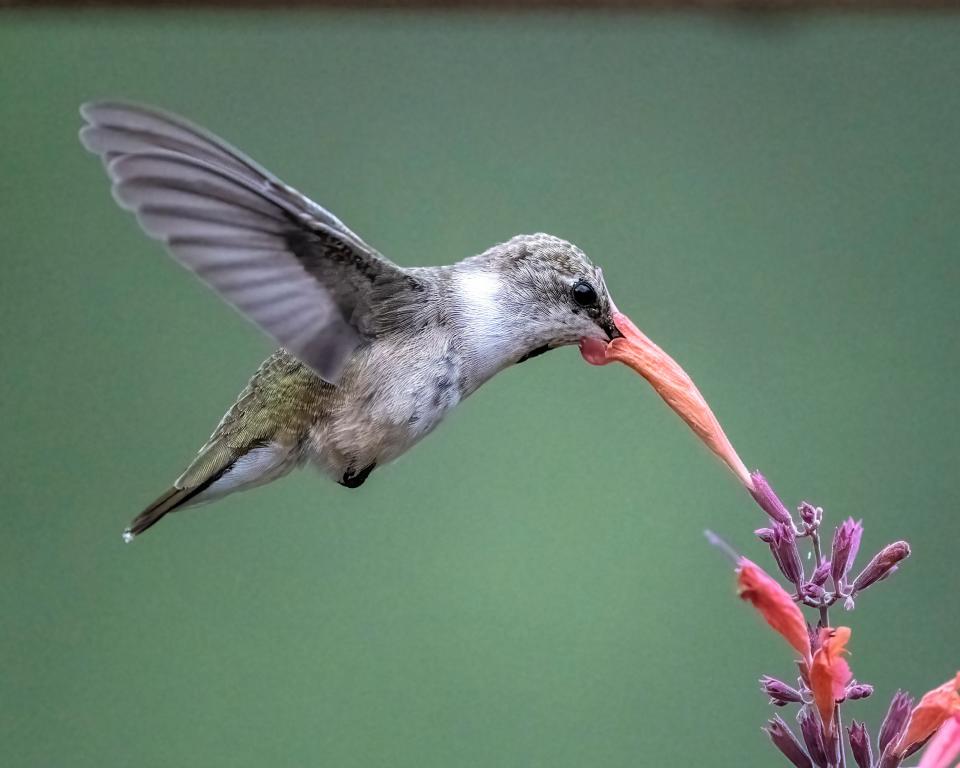Fall is the time for hummingbird migration through Abilene
If you have seen more hummingbirds around your garden, that’s because the fall migration has started.
Haven’t seen any at all? Well, let’s see if we can fix that.
Right now, they are fueling for their trip to Mexico and Central America. The hummingbirds in this area are black-chinned. If you see one that looks like a brand-new copper penny, that is a rufous. During migration, you may see some ruby-throats. Last year I had a hummingbird that was significantly larger and darker. He wouldn’t stop long enough for a picture, but he seemed to have some red coloring on his bill so he may have been a broad-billed, though they aren’t common in this area.

The best way to attract hummingbirds is to put out plants that will reel them in.
You don’t have to have a huge garden. One of my daughters-in-law had them visit her balcony garden. So, if space is a premium, that’s OK. Find a nice big plastic flower pot or two or even a plastic tote that you’ve drilled some holes in for drainage. Fill with potting soil and plant some pentas, lantana, petunias or salvias. Set pots on some cinder blacks or something similar where it’s more visible.
As most folks know, hummingbirds prefer flowers that are red or orange, but I’ve seen them on any good nectar plant, no matter the color. It’s just red and orange that draw them in. Blocks of color are going to catch their eye, so several of one plant will be fine. They like flowers that are tubular or trumpet shaped.
If you are looking to establish a more permanent garden for hummingbirds, I suggest three plants: flame acanthus, Turk’s cap and autumn sage. All three are perennials.
Flame acanthus and Turks’ cap both have orange flowers. They can get up to 3 feet or so, though not their first year. They will die back to the ground in winter and re-emerge in the spring. Cut back the old growth in late winter. Flame acanthus likes lots of sun. It’s one of the few things that can take Texas sun all day.
Turk’s cap, however, needs at least some shade.
Autumn sage comes in many colors, but I recommend red, hot pink and purple for the hummingbirds. It likes quite a bit of sun, but doesn’t mind some shade in the afternoon (who doesn’t?). Shear lightly after the first flush of flowers in the spring, then cut back by a third in late winter, before new growth begins.
Now, you might be wondering about feeders. Feeders are great and they give hummers the sugar energy they need especially before migration. But feeders are a responsibility. You can’t just put them out and forget about them. That’s what I did when I first began.
Sugar water goes bad. If the temperature is moderate, you can leave them for 3 or 4 days, but the hotter it is the more frequently they should be changed. Once temps are above 90, they should be changed daily. The best plan is to find feeders that have a wide mouth and are easy to clean. There are some out there that are even dishwasher safe. I avoid the fancy ones or just use them for decoration.
You don’t have to boil the water, though if the water is warm the sugar dissolves quicker. Don’t make too much. Even in the fridge, it will only be good for about a week. The ratio is 3 to 1 during migrating season (4 to 1 other times). So ¾ cup water to ¼ cup sugar will give you a cup of nectar. Don’t fill the feeders all the way. Fill to about half.
Please don’t use anything but water and white sugar. Anything else can be deadly. Feeders need to be either more than 10 feet from a window or closer than 3 feet to avoid collisions. Flying into windows can be deadly for birds, especially those as small and fast as hummingbirds.
If you don’t get any hummers the first year, keep trying. Once they find your yard they will keep coming back.
We hope that you will like our Facebook page at https://www.facebook.com/bigcountrymastergardeners. And visit the Big Country Master Gardeners at www.bcmgtx.org for information and future events.
This article originally appeared on Abilene Reporter-News: Fall is the time for hummingbird migration through Abilene

